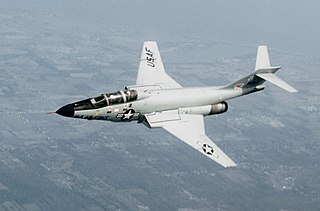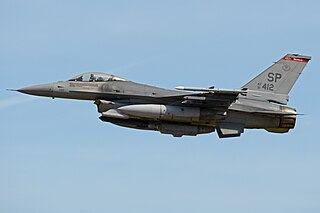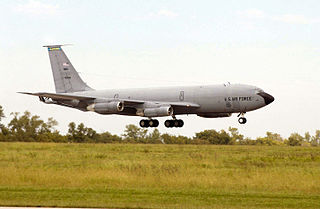
Strategic Air Command (SAC) was both a United States Department of Defense (DoD) Specified Command and a United States Air Force (USAF) Major Command (MAJCOM), responsible for Cold War command and control of two of the three components of the U.S. military's strategic nuclear strike forces, the so-called "nuclear triad", with SAC having control of land-based strategic bomber aircraft and intercontinental ballistic missiles or ICBMs.

The McDonnell F-101 Voodoo is a supersonic jet fighter which served the United States Air Force (USAF) and the Royal Canadian Air Force (RCAF).

The Douglas B-66 Destroyer is a light bomber that was designed and produced by the American aviation manufacturer Douglas Aircraft Company.

Yokota Air Base, is a United States Air Force (USAF) and Japan Air Self-Defense Force (JASDF) base in the city of Fussa, a city in the Tama Area, or Western Tokyo.

The Martin B-57 Canberra is an American-built, twinjet tactical bomber and reconnaissance aircraft that entered service with the United States Air Force (USAF) in 1953. The B-57 is a license-built version of the British English Electric Canberra, manufactured by the Glenn L. Martin Company. Initial Martin-build models were virtually identical to their British-built counterparts; Martin later modified the design to incorporate larger quantities of US-sourced components and produced the aircraft in several different variants.

Tactical Air Command (TAC) is an inactive United States Air Force organization. It was a Major Command of the United States Air Force, established on 21 March 1946 and headquartered at Langley Air Force Base, Virginia. It was inactivated on 1 June 1992 and its personnel and equipment absorbed by Air Combat Command (ACC).

Spangdahlem Air Base is a NATO air base with the USAF as a tenant constructed between 1951 and 1953 and located near the small German town of Spangdahlem, approximately 30 km NNE of the city of Trier, Rhineland-Palatinate.

Aerospace Defense Command was a major command of the United States Air Force, responsible for continental air defense. It was activated in 1968 and disbanded in 1980. Its predecessor, Air Defense Command, was established in 1946, briefly inactivated in 1950, reactivated in 1951, and then redesignated Aerospace rather than Air in 1968. Its mission was to provide air defense of the Continental United States (CONUS). It directly controlled all active measures, and was tasked to coordinate all passive means of air defense.

The 58th Reconnaissance Squadron is an inactive United States Air Force squadron. Its last was assigned to the 9th Weather Reconnaissance Wing at Kirtland Air Force Base, New Mexico, where it was inactivated in 1974.

The 152nd Airlift Wing is a unit of the Nevada Air National Guard, stationed at Reno Air National Guard Base, Nevada. If activated to federal service with the United States Air Force, the Wing is operationally gained by the 18th Air Force of the Air Mobility Command.

The 190th Air Refueling Wing is a unit of the Kansas Air National Guard, stationed at Forbes Field Air National Guard Base, Topeka, Kansas. If activated to federal service, the Wing is gained by the United States Air Force Air Mobility Command.

The 192d Airlift Squadron is a unit of the Nevada Air National Guard 152d Airlift Wing located at Reno Air National Guard Base, Nevada. The 192d is equipped with the C-130H Hercules.

The 117th Air Refueling Squadron is a unit of the Kansas Air National Guard 190th Air Refueling Wing located at Forbes Field Air National Guard Base, Topeka, Kansas. The 117th is equipped with the KC-135R Stratotanker.

The 358th Fighter Squadron is part of the 495th Fighter Group at Whiteman Air Force Base, Missouri. The squadron was reactivated there in 2015. The squadron was formerly part of the 355th Operations Group at Davis–Monthan Air Force Base, Arizona, operating the Fairchild Republic A-10 Thunderbolt II aircraft conducting close air support missions, until its 2014 inactivation.

The 57th Weather Reconnaissance Squadron is an inactive United States Air Force squadron. Its last assignment was with the 9th Weather Reconnaissance Wing at Hickam Air Force Base, Hawaii, where it was inactivated on 10 November 1969.

The 4080th Strategic Reconnaissance Wing is a discontinued United States Air Force (USAF) wing last assigned to the 12th Strategic Aerospace Division of Strategic Air Command (SAC) at Davis–Monthan AFB, Arizona. It was SAC's high altitude reconnaissance wing for its existence and was the first USAF wing to operate the Lockheed U-2. It was discontinued as part of a program to replace operational units controlled by major commands with those controlled by USAF whose lineages could be continued,

The Martin/General Dynamics RB-57F Canberra is a specialized strategic reconnaissance aircraft developed in the 1960s for the United States Air Force by General Dynamics from the Martin B-57 Canberra tactical bomber, which itself was a license-built version of the English Electric Canberra. It was operationally assigned to the Air Weather Service for weather reconnaissance involving high-altitude atmospheric sampling and radiation detection in support of nuclear test monitoring, but four of the 21 modified aircraft performed solely as strategic reconnaissance platforms in Japan and Germany.

The Martin RB-57D Canberra was a specialized high-altitude strategic reconnaissance aircraft developed from the Martin B-57 Canberra tactical bomber, a licence-built version of the English Electric Canberra. It was used by the United States Air Force during the 1950s prior to operational use of the Lockheed U-2.


















